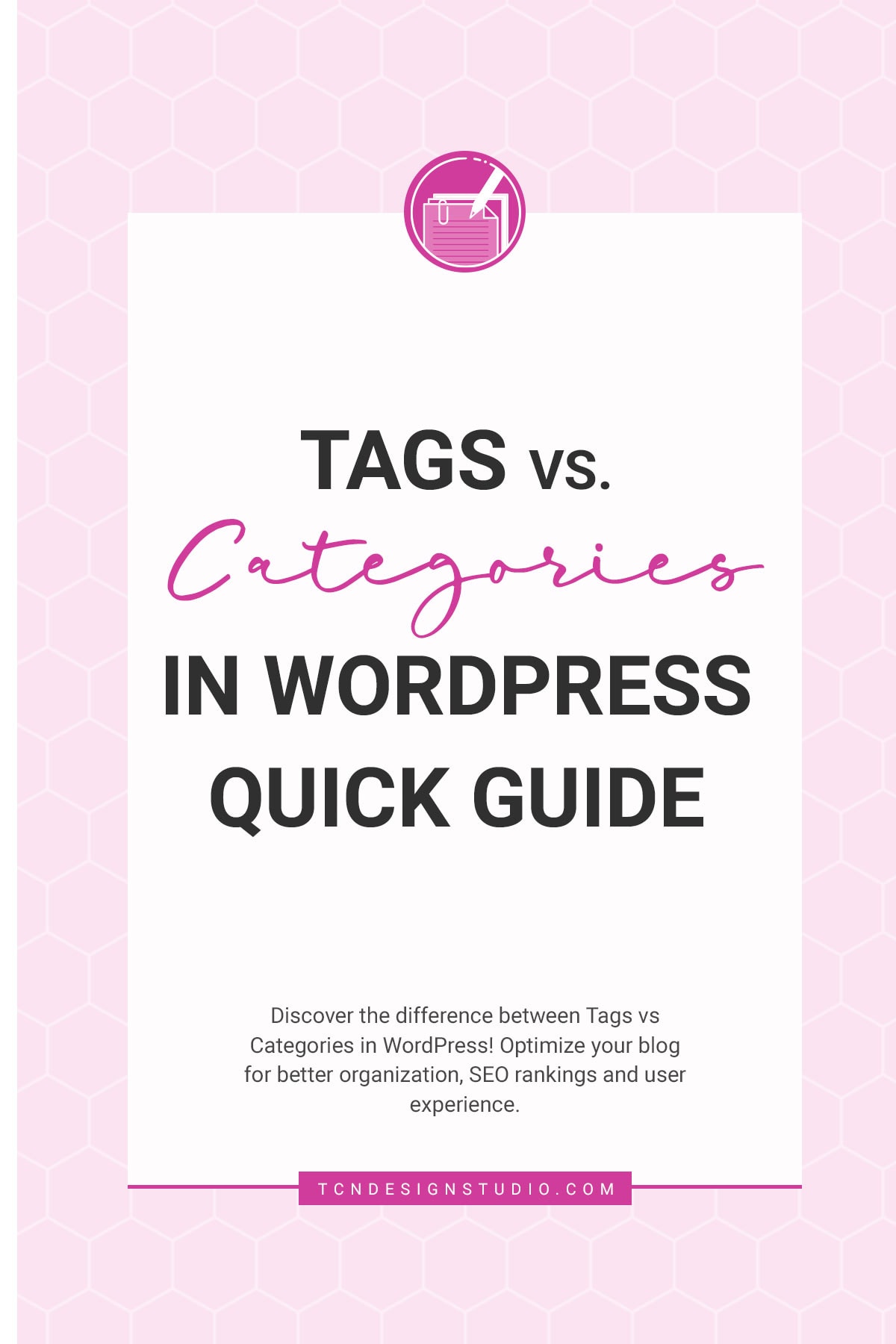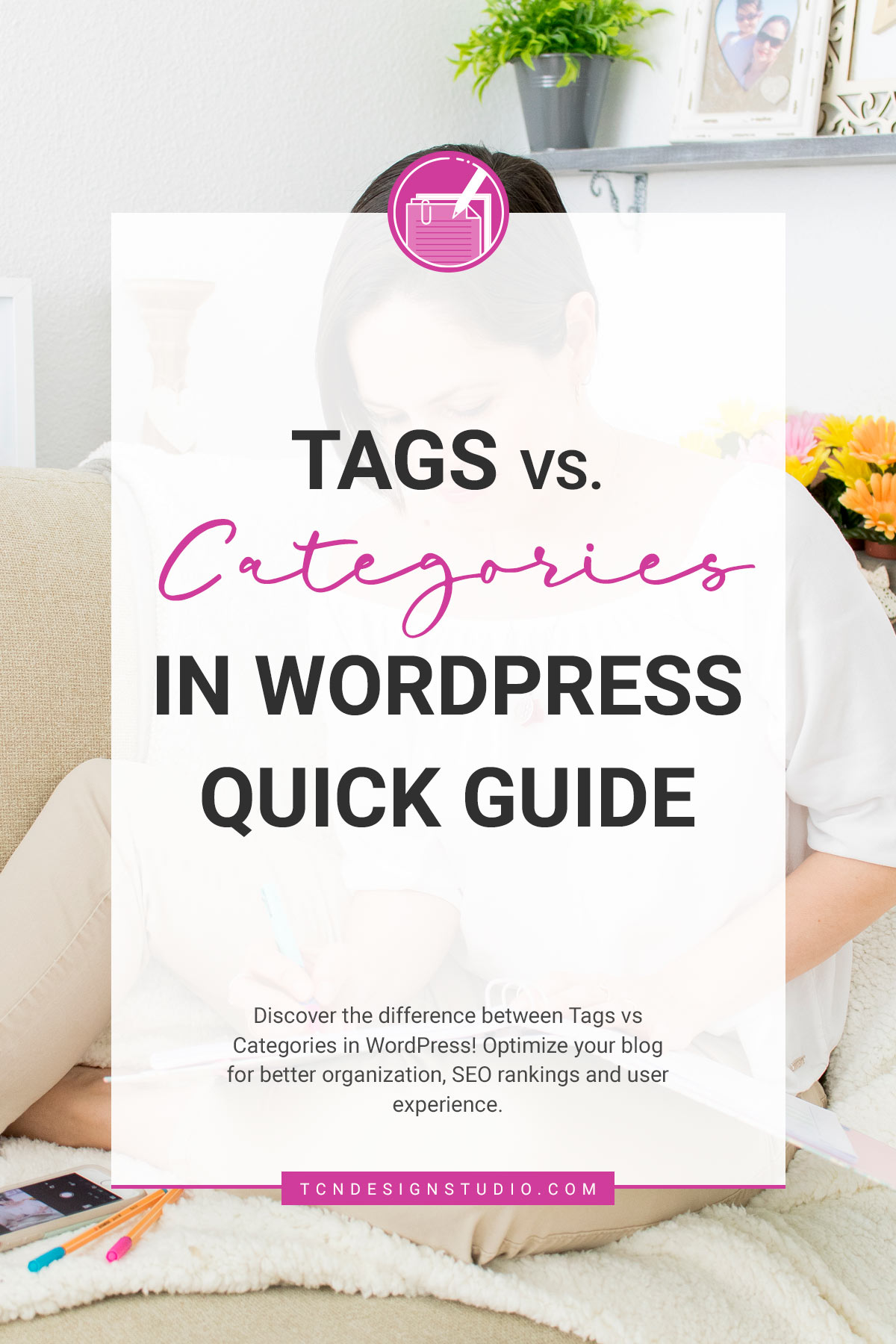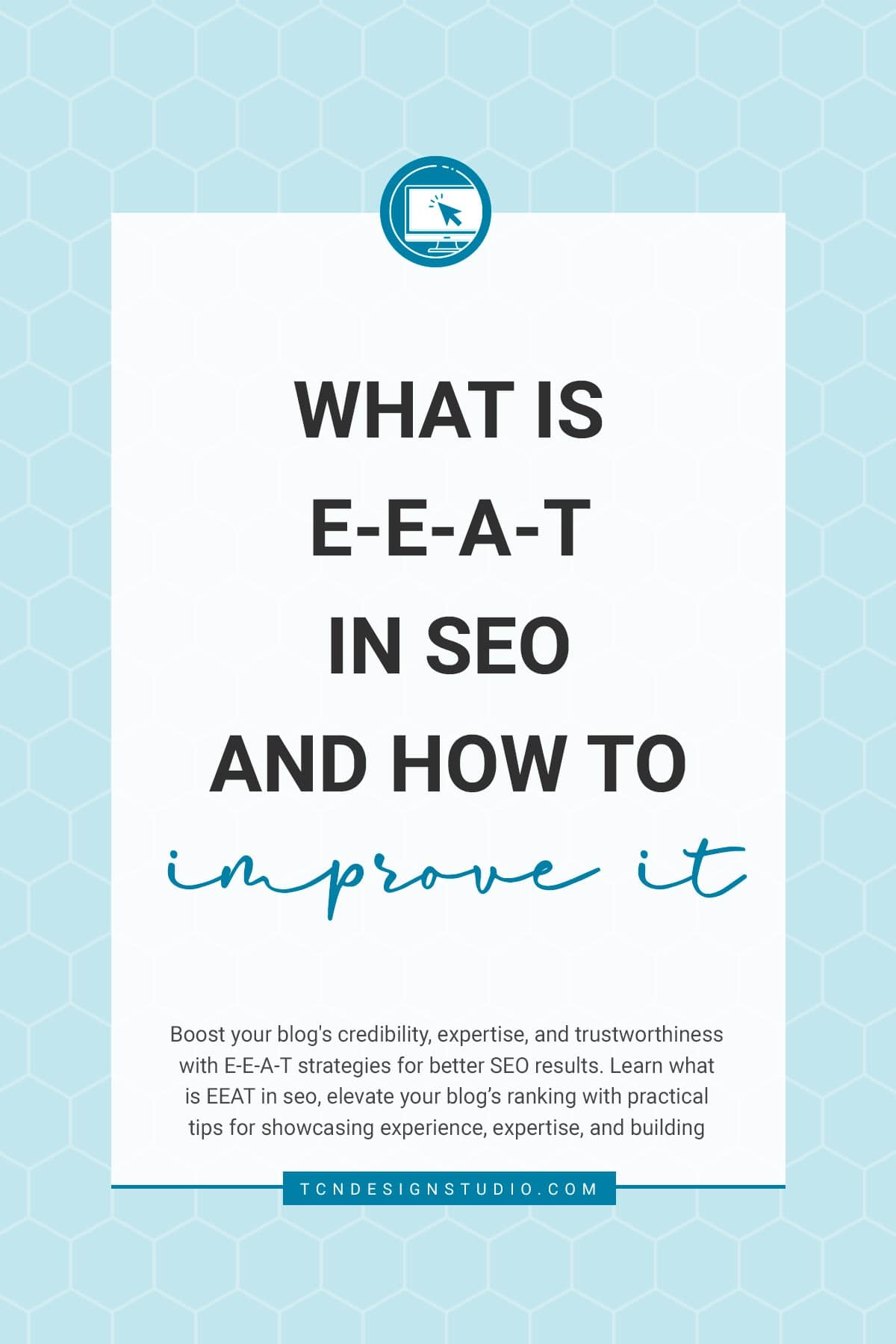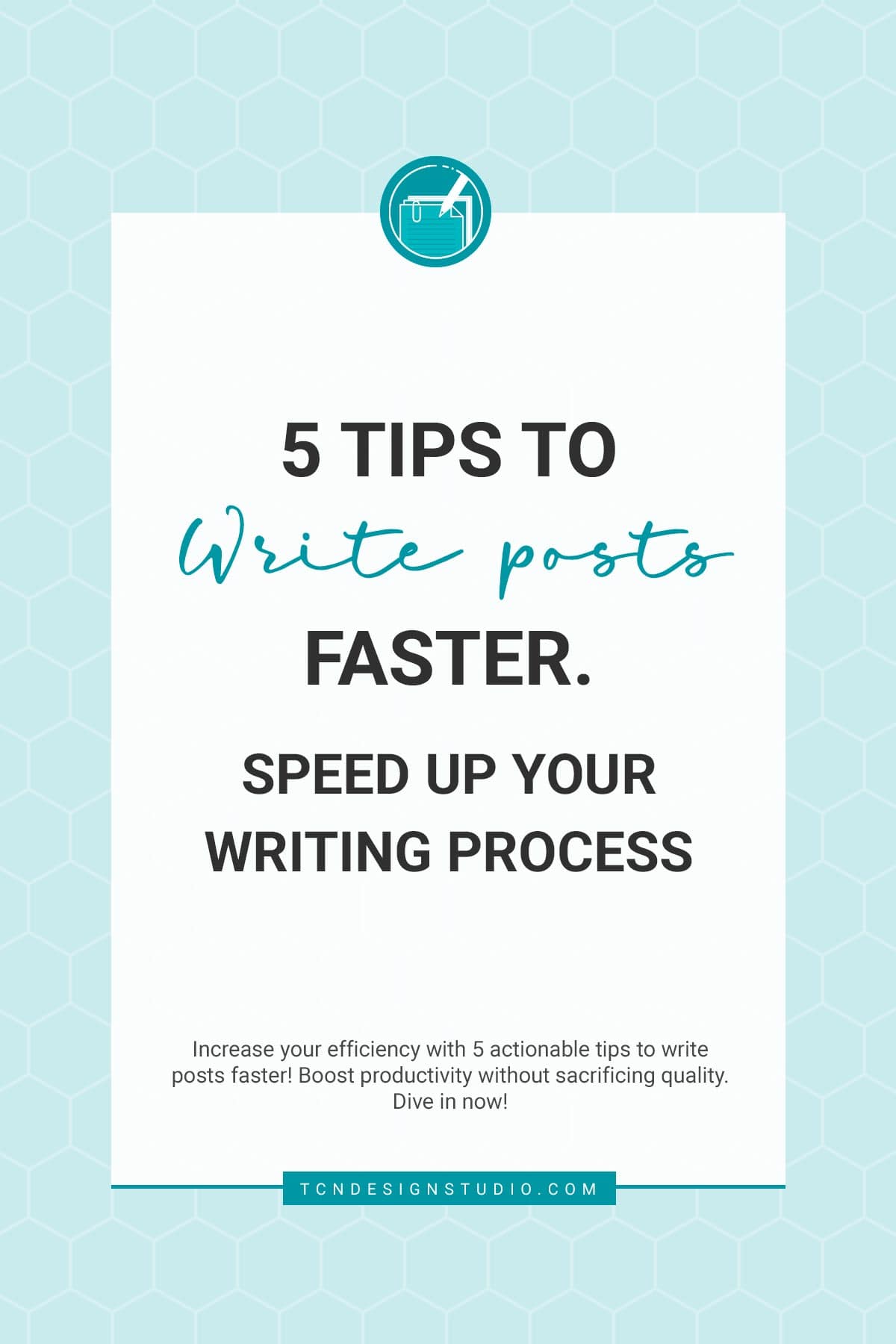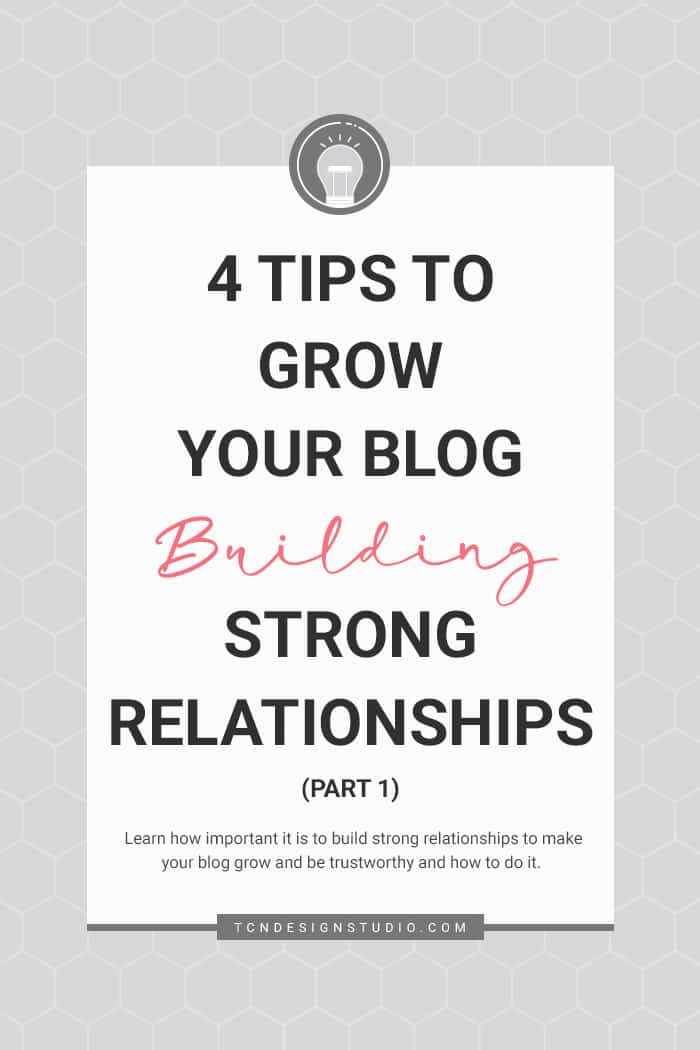Tags vs Categories in WordPress Quick Guide
Discover the difference between Tags vs Categories in WordPress! Optimize your blog for better organization, SEO rankings and user experience.
Let’s have a little heart-to-heart about our blogs using WordPress categories and tags. Today we’re diving into a topic that’s near and dear to every blogger’s heart – organizing your blog categories for maximum impact.
Stick with me as we explore the ins and outs of categorization and how it can elevate your blog the next level.

You might be wondering, “What are these categories and tags, and do they even matter?” Well, let’s break it down for you!
Why Categories Matter
First things first, let’s chat about the importance of categories. Picture your blog as a beautifully curated library, with each category serving as a distinct section filled with valuable content. When your blog is well-organized, navigation becomes a breeze, and your readers’ experience is seamless and enjoyable.
Categories vs Tags in WordPress: Understanding the Difference
Before we dive deeper, let’s clarify the distinction between categories and tags. At their core, both serve to organize your content, but there’s a subtle yet significant difference. Categories offer a hierarchical structure, allowing for parent categories and subcategories. Tags, on the other hand, are more straightforward and one-dimensional, perfect for labeling specific content elements like ingredients, tools, or supplies.
Categories:
Picture them like the big sections in a bookstore. You have Literature, Science Fiction, fantasy, Non-fiction, Science, etc. Well, when you write a blog post, you toss it into a category that best fits the post’s main topic just like you would with a book. Imagine you’re organizing your craft supplies into separate labeled boxes — easy to find them when needed, right? Categories do that for your blog content!
You can further organize your categories with sub-categories also called nested categories. For example, for a food blogger, “Dessert” would be the main category, and then have “Pies and tarts”, “Cheesecakes”, “Mousse and Custards”, “Cakes”, etc.
This will help your readers find what they are looking for more easily than just landing on a sea of dessert recipes and having to scroll for ages without even knowing if they will find what they might be looking for.
Yes, they could just search, but think that sometimes people are just looking for ideas and they don’t know exactly what they want but maybe they know they want a cheesecake.
It’s about making the navigation easier for your audience.
Tags:
Tags are like sticky notes on the dividers in your organized craft boxes, specifying what’s inside. They’re more detailed and help your readers find something specific, like “strawberries” in a dessert recipe. Tags make your content searchable and accessible, just like labeling those craft box dividers makes finding your perfect ribbon a breeze.
Now, about their role in the grand scheme of SEO and growth? Truth be told, tags aren’t the SEO superheroes we sometimes wish for or used to be ages ago. They don’t hold the cape, but they’re great sidekicks! They don’t play a massive role in your blog’s rankings, but they can be your readers’ best friends when it comes to navigating your content.
Tags should be set as “No Index”
First things first, let’s grasp what “no index” means. When you designate a page or content as “no index,” you’re essentially telling search engines not to include that particular page in their search results. This is a powerful tool in controlling what appears in search engine listings.
Why Set Tags as “No Index”?
Now, why would we want to set our tags as “no index”? Here are a couple of compelling reasons:
- Prevent Duplicate Content Issues: Tags are essentially a way to group similar content. However, they can create what’s called “duplicate content” in the eyes of search engines. When a tag page displays multiple posts with the same tag, it’s like having the same content in different places, which can dilute SEO efforts. By setting tags as “no index,” you avoid this duplication problem.
- Prioritize Essential Content: You want your best foot forward when it comes to search engine results. Pages like your homepage, key categories, and important blog posts deserve that spotlight. By setting tags as “no index,” you’re guiding search engines to focus on your core content, ensuring it gets the attention it deserves.

How to Set Tags as “No Index” in WordPress
Alright, let’s talk implementation. Thankfully, this is relatively straightforward:
- Using a Plugin: There are many SEO plugins available for WordPress. Install a reputable one (like Yoast SEO or All in One SEO Pack), and within its settings, you can easily set tags as “no index.”
- Edit Robots Meta Directly: For those comfortable with code, you can edit the “robots meta” for each tag page. This involves adding a meta tag like within the HTML code of the tag pages you wish to set as “no index.”
What do Categories and Tags look like for bloggers
🥣 For Food Bloggers:
Let’s say you’re a foodie writing a dessert recipe. You’d pop it in the “Desserts” category box. Now, imagine someone’s craving a dessert with strawberries, but they’re not sure what kind. By tagging your post with “strawberries,” you’re making their hunt for the perfect strawberry dessert a piece of cake! This is super true especially if you are using filtering systems.
✂️ For DIY and Craft Bloggers:
Now, let’s step into the world of crafts. Imagine you’ve crafted a great tutorial on handmade cards.
Into the “Handmade Cards” category box it goes. Tagging it with “Cardstock” and “scrapbook paper” is like labeling the craft box, so when someone’s into cardmaking, they can easily find your fantastic tutorial.
Remember, while tags won’t skyrocket you to Google’s top spot, they sure can offer your readers a more delightful browsing experience on your blog.
Why Use Categories and Tags?
Now that we know what they are, let’s talk about why they matter:
- Organization: Categories and tags keep your blog neat and organized. They help both you and your readers quickly locate and browse through your content.
- User Experience: Think of categories as the main sections of a store and tags as the product labels. They enhance the user experience by making it easy for readers to find the content they’re interested in.
- SEO Friendliness: While tags don’t have a massive impact on SEO rankings, they do contribute to your blog’s overall SEO. They make your content more accessible to readers and can help with internal linking.
Now, let’s address the elephant in the room – how many categories should you have, and how do you decide? It all starts with understanding your blog’s niche. Remember, your blog is more than just a food or Craft haven; it’s a unique space that reflects your passions and expertise. Take a moment to assess your recent posts and identify common themes or topics. These will serve as the building blocks for your category structure.
Filling Out Your Categories
Now, let’s talk about category depth. Think of your categories as a vault waiting to be filled with valuable content. Aim for a robust selection of posts within each category, ideally four to five to start. This ensures that each category feels substantial and worthwhile for your readers.
And don’t forget to refine your category descriptions – they’re your chance to provide context and insight into what each category offers. It’s also recommended that you have a custom headline for your Categories. This helps by increasing your chances of showing up in search result with better crafted headlines for your Categories.
It’s not the same trying to rank for “Side Dish” as it would be for “30-minute Side dishes”.
This can be accomplished by adding a custom function to your wordpress or through plugins. I recommend doing it through code to avoid adding more and more plugins. If you need help with this feel free to reach out through our contact form.

Improving and Fixing Old Categories
Feeling overwhelmed by your existing category chaos? Don’t worry, we’ve got a plan. Start by creating a spreadsheet to assess your current categories, including post count and descriptions.
This bird’s-eye view will help you identify areas for improvement, whether it’s consolidating overlapping categories or expanding into new territory. With a clear roadmap in hand, you’ll be well-equipped to streamline your categories and provide a more cohesive browsing experience for your readers.
The Important Role of an Index Page in the Category Organization.
Let’s talk about something incredibly valuable for your blog – an index. An index is like the map that guides your readers to specific content they’re interested in. Imagine someone comes to your food blog craving a dessert with strawberries, but they’re not sure what exactly they want. This is where an index with post grid filtering comes into play.
Recipe or Project Index
Imagine you’re a food blogger, and you’ve tagged all your dessert recipes with ingredients like “strawberries,” “chocolate,” and “vanilla.” When a reader lands on your blog and they’re in the mood for something sweet, but they’re not sure what, they can use your index to find a recipe.
Here’s how it works:
Categories: You have a “Desserts” category where all your dessert recipes reside. This is like the “Dessert Section” in our library analogy. The reader clicks on it and a sea of desserts displays.
Tags: You’ve tagged each dessert recipe with specific and commonly searched for ingredients. Then, if a reader selects “strawberries,” they instantly get a list of all your recipes that feature strawberries.
Conclusion
Organizing your blog categories is more than just housekeeping – it’s a strategic move that can shape the entire user experience of your blog. By thoughtfully curating your categories, you’ll not only make navigation a breeze for your readers but also establish your blog as a go-to destination in your niche. So roll up your sleeves, dive into those categories, and let’s take your blog to the next level together!
Need help figuring out your Categories and Tags, Learning SEO, or even where to start? Get in touch and let’s talk!
Frequently Asked Questions
Categories organize your content, enhancing navigation and user experience, vital for attracting and retaining readers.
Categories offer hierarchy, ideal for broad topics, while tags provide specific labels for individual posts or elements.
Aim for a balance; too few categories may oversimplify, while too many can overwhelm. Start with 5-10 primary categories and go from there. Be mindful about this. Set categories that are actually relevant.
Consider your niche and recent posts. Group similar content together, focusing on topics your audience finds valuable and engaging.
Consolidate overlapping categories and delete or repurpose irrelevant ones. Keep your category structure focused and streamlined for better user experience.
More Blogging Posts To Read
If you enjoyed learning about Tags vs Categories in WordPress, you might also love these other blogging-related articles too:
- 5 Tips to Write Posts Faster. Speed Up Your Writing Process
- 7 Things to Increase Your Page RPM You can do today
- SEO Friendly Content: A Comprehensive Guide plus SEO Checklist (Free Printable)
- 7 Things Your Blog Needs to Improve and Optimize User Experience
Don’t forget to share and save this post!
